This post may contain affiliate links. I only recommend products or services that I personally use or trust, promise!

Gamjatang is definitely in my top 5 favorite Korean soups, and if you know anything about Korean culture then you know it’s the nation of broth! Soup is fundamental to Korean cuisine & culture- there are so many to choose from and I would choose gamjatang every time!
Made with pork neck bones, this soup is hearty, spicy, and so comforting especially on a rainy day.
Why is it called gamjatang?
“Gamja” means potato and “tang” means soup in Korean, so up until I started my r&d for this recipe, I thought gamjatang meant potato soup. Apparently thats not the correct translation!
“Gamja” is also a Korean word that refers to part of the pork spine. Some readers have also told me that the original gamjatang didn’t even have potatoes in it, but restaurants started adding them because of the confusion over the name.
I know I can’t be the only one who didn’t know this. I avoided this dish on Korean menus for most of my life because I didn’t grow up eating it, so I didn’t know what it was. When I would see gamjatang on a menu, I really thought it meant potato soup and just wasn’t interested in it, so I never ordered it.
Funny enough, my mom thought the same thing even know she actually grew up in Korea. She didn’t try gamjatang until she was in her late 40’s! So we learned how to make this dish together and this is the recipe we came up with 🙂
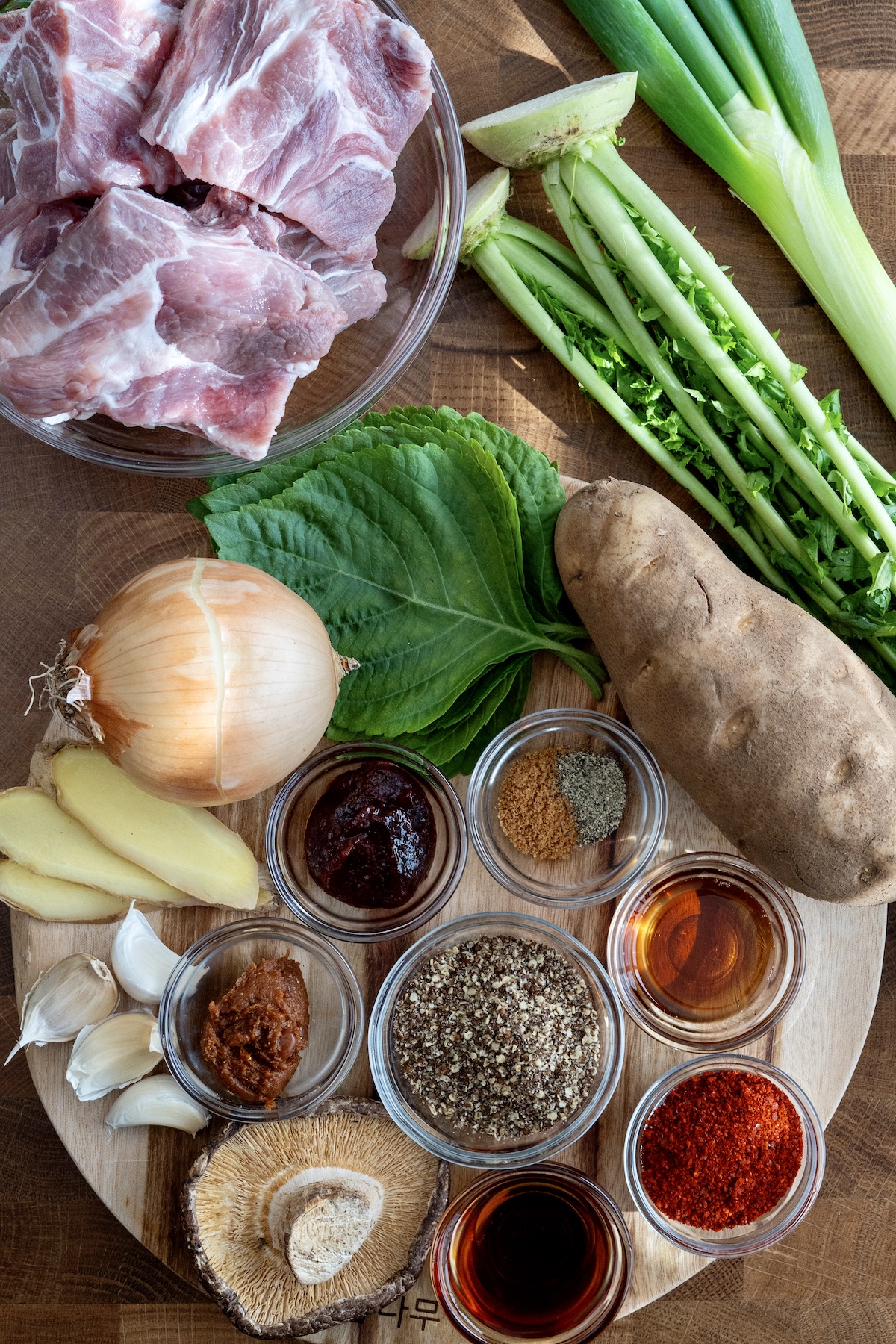
Ingredients
- Pork neck bones- gamjatang is best made with pork neck bones. These have a lot of flavor and the meat is so delicious and tender! Look for bones that have the most meat on them.
- Aromatics– onion, large green onion, ginger, garlic, & dried shiitake mushroom.
- Seasoning paste- gochujang (Korean red pepper paste), gochugaru (Korean red pepper flakes), perilla powder, fish sauce, plum syrup, black pepper, and Knorr chicken bouillon.
- Young radish greens- this is actually my favorite part of this dish, besides the soup! The radish greens take on the flavor of the broth really well. You can also use napa cabbage instead if you prefer.
- Perilla leaves- even if you don’t really like perilla leaves, you should definitely add them because it is really delicious with this soup!
- Potato– one large russet potato cut into 6 pieces.

More soup recipes
If you like this recipe, try some of my other soup recipes on the blog!
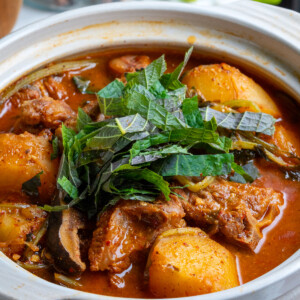
Gamjatang (Pork Bone Soup)
Ingredients
- 2 lbs pork neck bones
- 8-10 cups water
- 2 tbsp doenjang, (fermented soybean paste)
- 1 oz sliced ginger, or 3 bay leaves
- 1 small onion
- 1 dried shiitake mushroom
- 1 daepa (large green onion), or 2 green onion
- 10 perilla leaves
- 1 large russet potato, peeled & cut into 6 pieces
- 1/2 lb young radish greens, or napa cabbage
- 1 serrano pepper, or Korean spicy pepper if you can find it
Seasoning paste
- 4 garlic cloves, minced
- 2 tbsp gochugaru, (Korean red pepper flakes)
- 1 tbsp gochujang, (Korean red pepper paste)
- 2 tbsp fish sauce
- 3 tbsp perilla powder
- 1/2 tsp black pepper
- 1 tbsp plum syrup
- 1 tbsp Knorr chicken bouillon
- 2 tbsp water
Instructions
- Soak the pork neck bones in cold water for an hour, changing the water once or twice.
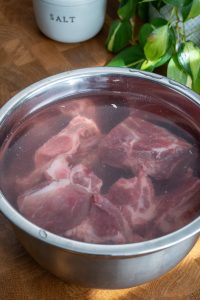
- Meanwhile, prepare the minced garlic, chopped green onion, sliced ginger, sliced onion, and washed young radish stems. Tip: Potatoes oxidize when peeled, so you can either wait to peel it until you need it, or peel and cut them and hold them in a bowl of cold water to prevent browning.
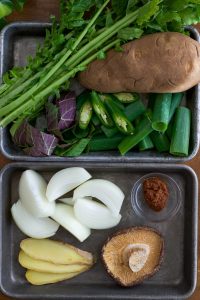
- Make the seasoning paste: combine the garlic, gochujang, gochugaru, fish sauce, perilla powder, black pepper, plum syrup, water, and Knorr chicken bouillon. Set aside.
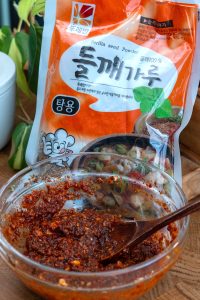
- After 1 hour of soaking the pork neck bones, drain and add them to a pot with enough room temperature water to cover them. Bring it to a boil- this will take about 10-15 minutes, and once it starts boiling, only let it boil for a couple minutes. This is an asian technique for blanching meat. It gets rid of the gaminess and impurities in the pork.
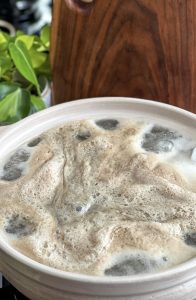
- Drain and rinse the pork bones thoroughly, making sure to get all the gunk out of the crevices of the bones.
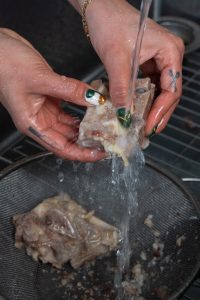
- Put the pork bones back in a cleaned pot. Add 8 cups of water, ginger, onion, dried shiitake mushroom, and fermented soybean paste. Bring to a boil, skim off any remaining impurities that float to the surface, then reduce the heat to medium and cover for 90 minutes. Tip: thoroughly mix the fermented soybean paste with 1/2 cup of water before adding it into the pot, so it mixes in easier.
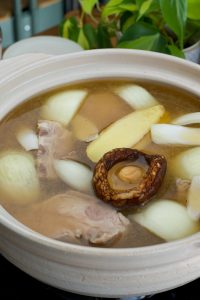
- In a separate pot, bring water a boil then blanch the young radish greens for 1-2 minutes. Set aside.
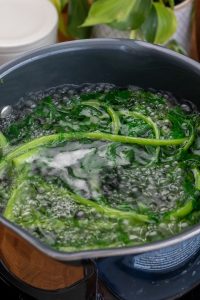
- After 90 minutes, throw away the ginger and take out the shiitake mushroom to slice it.
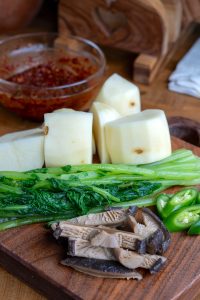
- Add 1 to 2 cups of water to the pot, then add the seasoning paste and mix well. Then add the potatoes, green onion, blanched radish greens, sliced shiitake mushrooms, and sliced serrano pepper. Cover for another 30 minutes.
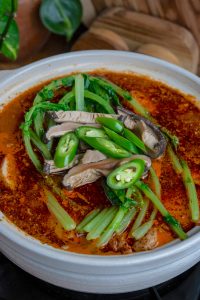
- After 30 minutes the potatoes should be chopstick tender. Add the sliced perilla leaves last to finish, and thats it!
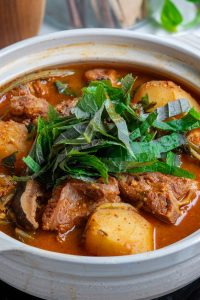
Nutrition information is automatically calculated, so should only be used as an approximation.
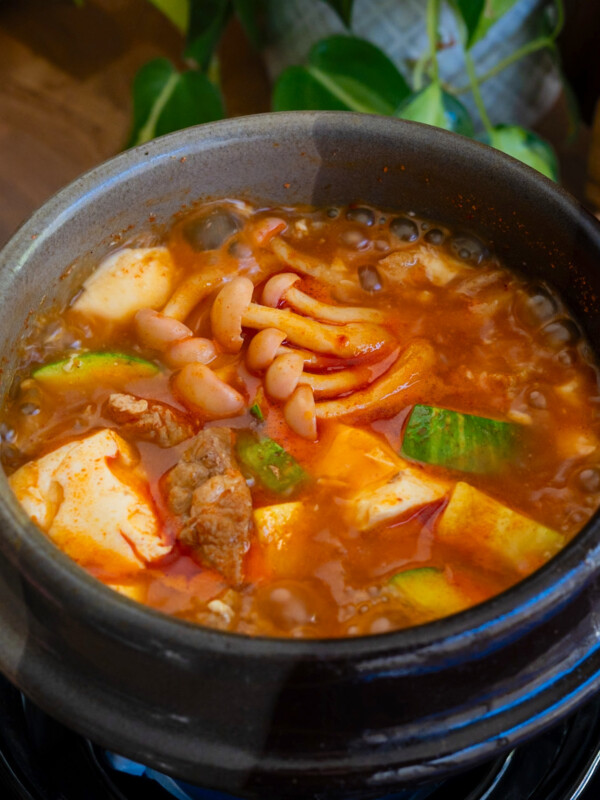
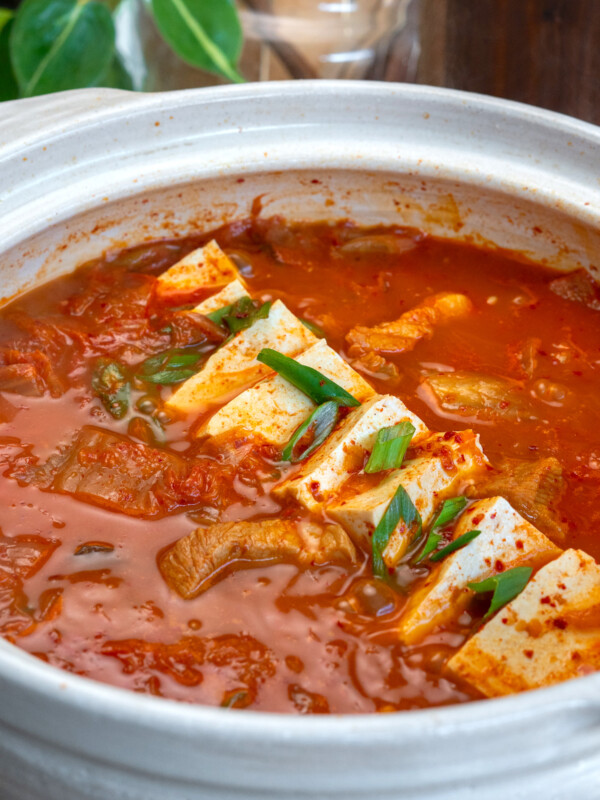
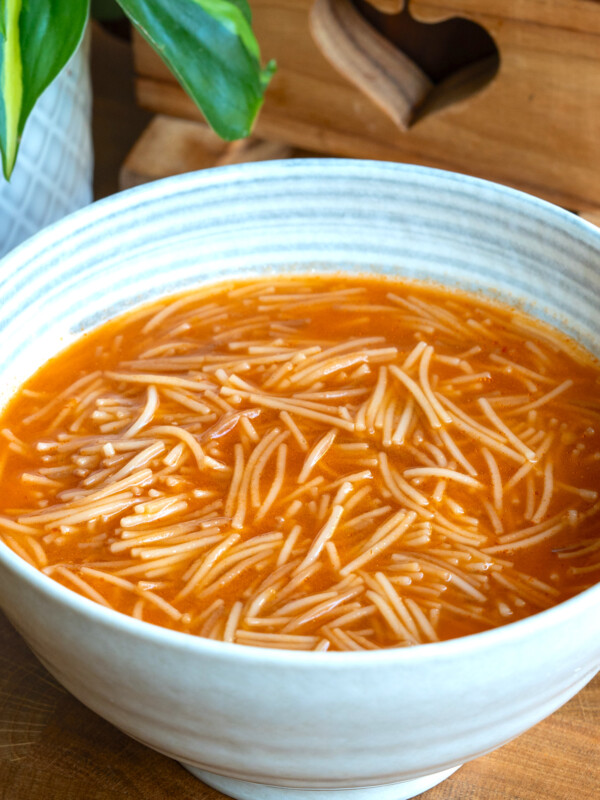

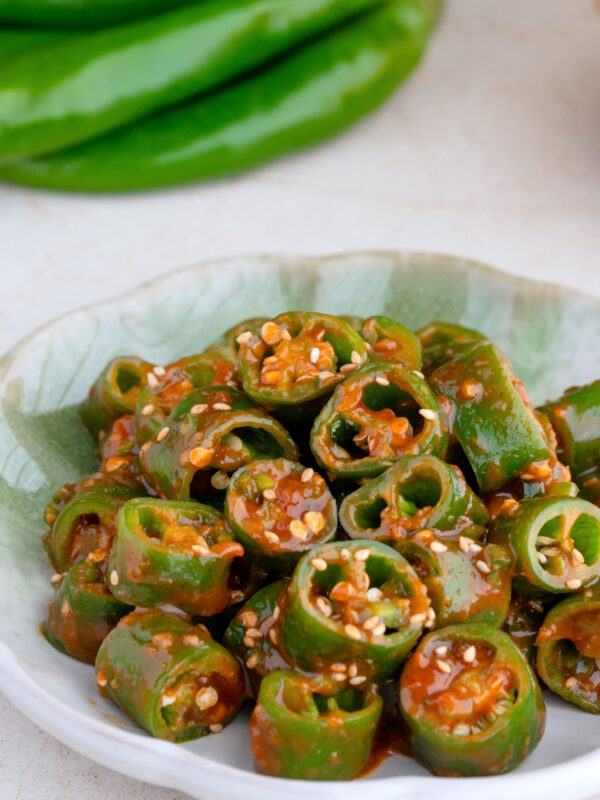
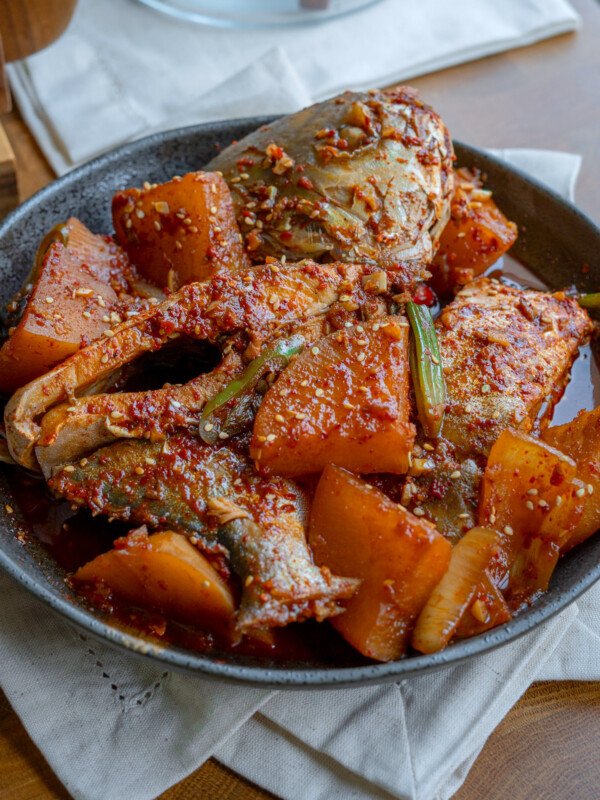
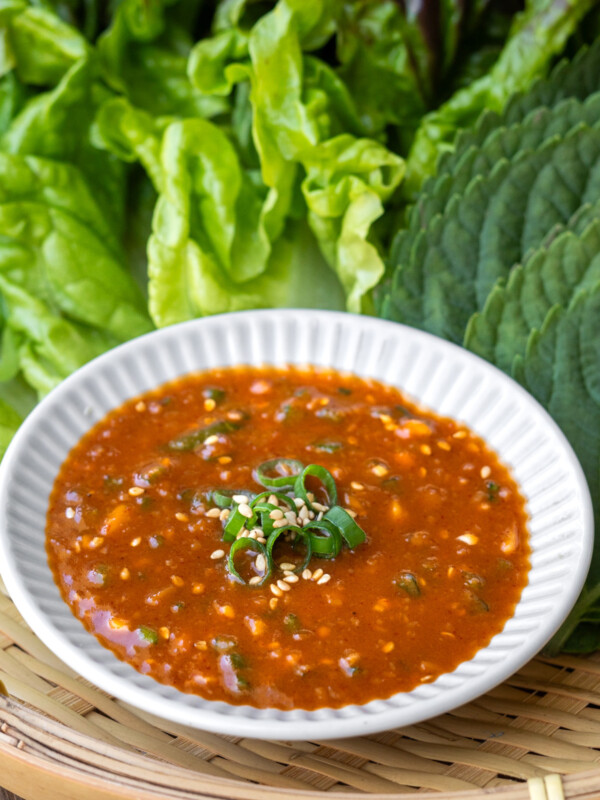
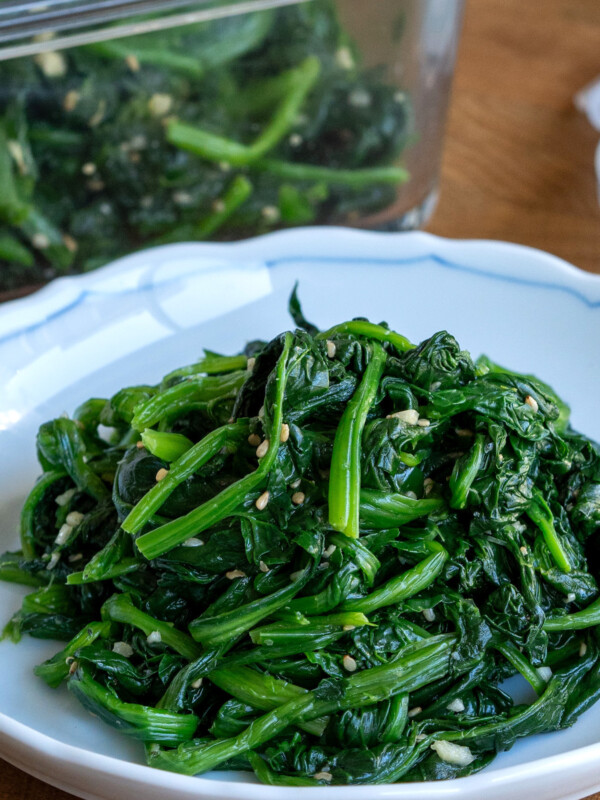







Tried making this after craving some good homemade Korean soup and it was so easy to follow and turned out amazing!
My dad would always make this in a HUGE pot when my brother and I were growing up. I remember how much love and sweat was put into the dish each time he made it. Super nostalgic dish for me ❤️ No one quite makes it as good or as dank as my pops did, so I’m excited to try yours 누나! We put extra extra 들깨 🙆♂️
Aloha Stella! I’m multicultural as well, but Korea is my soul!! This soup always hits the spot!! Mahalo for all your ONO recipes!!
This recipe is very concise and easy to follow along with, the dish leaves no stone unturned as you find yourself enveloped in a cloak of joy. I’d give it a higher rating if I could but alas 5 stars will have to do.
This is one of my favorite Korean soup dish. It’s similar to Philippines neck bone soup called Nilaga except for spiciness. When I saw Gamjatang when I was leaving in Seoul, I fell in love 🥰 😍. THIS recipe is FANTASTIC and a keeper
I love all your recipes but my fave right now is the grapefruit cheong!!!!! 👍🏼👍🏼👍🏼👍🏼🥰👍🏼 keep doing your thing!
This looks delicious. I find it so hard to find perilla leaves any substitute? Thanks!
The heartiest and most delicious soup. Literally soothes the soul!
I enjoyed watching the Paleta videos. Homemade delish-ness. So easy to make and refreshing!
I loooooove ordering this at restaurants but seeing your recipe makes me feel like I can make it just as good as they do but at home! I make a lot of noodle soups at home and I bet this will be awesome as a noodle soup base even though a lot of people eat with rice.